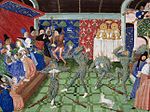Portal:Europe/Featured article/4
The nobility. Four of the dancers were killed in a fire caused by a torch brought in by a spectator, Charles' brother Louis, Duke of Orléans. King Charles and the remaining dancer, the noble knight Ogier de Nantouillet, survived. The ball was one of a number of events intended to entertain the young king, who the previous summer had suffered an attack of insanity. The event undermined confidence in Charles' capacity to rule; Parisians considered it proof of courtly decadence and threatened to rebel against the more powerful members of the nobility. The public's outrage forced the king and his brother Orléans, whom a contemporary chronicler accused of attempted regicide and sorcery, into offering penance for the event.
Charles' wife,
illuminated manuscripts by painters such as the Master of Anthony of Burgundy. The incident later provided inspiration for a scene in Edgar Allan Poe's short story "Hop-Frog
".

